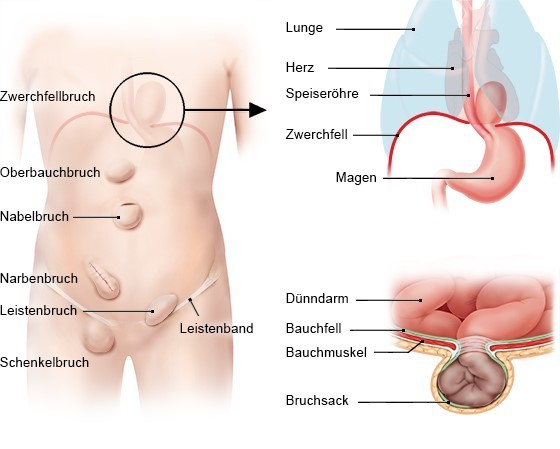In a hernia (also known as a hernia of the intestines or hernia), the peritoneum or intestines usually protrude through a gap in the abdominal wall. The peritoneum is the skin that lines the abdominal cavity and completely or partially surrounds most of its organs. The contents of the hernia are called the hernia sac and may contain parts of organs such as the intestine or stomach. Usually a bulge forms that is visible from the outside. Whether a hernia causes problems depends on where it originates and how large it is.
The most common hernias are:
- Inguinal hernia (groin hernia): occurs at a weak point above the inguinal ligament. Inguinal hernias are the most common hernias and mostly affect men.
- Femoral hernia (thigh hernia): mostly affects women and occurs on the thigh below the inguinal ligament.
- Incisional hernia (scar hernia): occurs in the area of a surgical scar. The abdominal wall is weakened at this point and more prone to herniation.
- Abdominal hernia (umbilical hernia): occurs at a weak point of the abdominal wall in the navel area. Umbilical hernia is common in infants and overweight adults.
- Upper abdominal hernia (epigastric hernia): forms through a gap in the abdominal wall between the sternum and the belly button.
A special form is the diaphragmatic hernia. It occurs when one of the gaps in the diaphragm widens and the peritoneum or parts of the stomach bulge from the abdomen into the chest. Such a hernia is not visible from the outside and is therefore called an “internal hernia”.
Most fractures remain permanent if they are not treated. An exception is umbilical hernias in infants, which usually heal on their own during the first two years of life.

Symptoms:
Most abdominal wall hernias can be palpated or even seen as protrusions. Not all hernias cause discomfort. However, they can cause pain, burning, pressure sensations and pulling, especially during physical exertion. Some people only experience discomfort when they strongly tighten the abdominal muscles.
If the bowel is constricted in the area of the hernia, digestive problems may occur. In the case of a hernia, tissue can enter the scrotum, which then swells severely (testicular hernia).
Severe or new onset of pain at the hernia or additional nausea and vomiting indicate that the hernia sac is entrapped. This can result in serious complications such as peritonitis.
Large abdominal wall hernias, which can be clearly seen from the outside, are very unpleasant and can be psychologically very stressful.
A hiatal hernia causes different symptoms than an abdominal wall hernia. This internal hernia can cause heartburn, difficulty swallowing and difficulty breathing. The discomfort can be treated with medication and the hernia can be repaired by surgery.
